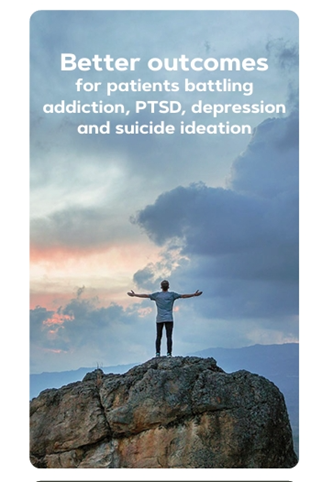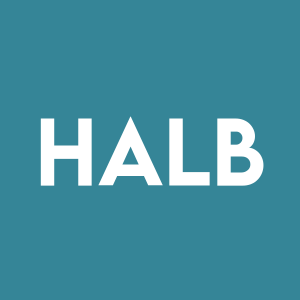Halberd Corp. Issues Letter to Shareholders - Patented LDN+ Evolves into WatchDawg™ for Veteran Suicide Reduction
Rhea-AI Summary
Halberd (OTC: HALB) has issued a letter to shareholders announcing the evolution of its patented LDN+ into WatchDawg™, a solution aimed at reducing veteran suicides. Utilizing a combination of Low Dose Naltrexone and a muscle relaxer MethoCarbamol, WatchDawg is designed to offer relief for various conditions including PTSD, addiction, and depression.
The pilot study data is promising, showing significant improvements in patients and reducing reliance on opioids. The product incorporates advanced wearable technology for real-time health monitoring, providing insights into patient health trends and enabling better management of PTSD and related conditions. The company plans to commercialize WatchDawg without requiring FDA clearance initially, using compounding pharmacy rules, and will seek FDA Fast Track designation based on pilot study outcomes.
Halberd is also exploring the potential to franchise the WatchDawg business model to expand its reach and help more veterans and individuals dealing with mental health issues.
Positive
- Promising pilot study data shows significant improvement in patient outcomes.
- Reduction in reliance on opioids due to LDX and WatchDawg.
- Potential for FDA Fast Track designation based on pilot study results.
- Exploring the franchise model to expand reach and increase revenue.
Negative
- Dependence on FDA's review process, which can delay product commercialization.
- Managing quality control in a potential franchise model.
News Market Reaction 1 Alert
On the day this news was published, HALB gained 26.92%, reflecting a significant positive market reaction.
Data tracked by StockTitan Argus on the day of publication.
Early Pilot Study Data from Veteran Volunteers is Compelling - Part B
JACKSON CENTER, Pa., Sept. 09, 2024 (GLOBE NEWSWIRE) -- Halberd Corporation (OTC: HALB) today issued the following letter to its shareholders:
We hope you have had an opportunity to check out last week’s Press release, Part A. This Part B supplements that release of a few days ago. As always reach out to us if you have any comments or thoughts. Good or bad, we appreciate them!
The PTSD market is evolving. It is also growing quite rapidly in terms of CAGR and rate of growth.

Key Drivers of PTSD Market Growth:
Increasing Awareness: Growing awareness and recognition of PTSD, particularly among veterans, first responders, and individuals experiencing trauma, continues to contribute to higher demand for treatment and support services. This is a hurdle as many with PTSD do not come forward and admit it. This is slowly changing.
- Rising Incidence: The prevalence of PTSD is increasing due to factors such as military conflicts, natural disasters, and other traumatic events, driving demand for effective treatment solutions. This identifies that PTSD is not a “military service” trauma only.
- Advancements in Treatments: Innovations in pharmaceuticals, psychotherapy, and digital health technologies enhance treatment options and support for PTSD patients. Still the questions remain: is it working, and how do we know?
- Government and Institutional Support: Increased funding and support from governments and organizations to address PTSD, particularly for veterans and at-risk populations. Recent solicitations on mental health from the government are increasing at record rates. They all know they have an issue here and are seeking solutions.
- Integration of Services: The integration of mental health services into primary care and broader healthcare systems, including telehealth and insurance coverage, improves access to PTSD treatment and support. We tuned in specifically on this trend.
- What WatchDawg Does: We offer a remote ability to bridge any ongoing current therapy with a comprehensive new approach to render advanced capability to heal from the PTSD. Yes, LDX and WatchDawg is a much more applicable solution than what we had in LDN+. We were noticed!
A medication combination, LDX (Low Dose Naltrexone and a low-dose muscle relaxer MethoCarbamol with other proprietary ingredients) is described in our provisional patent filed last week to provide safe, adjunctive relief but not a “wonder” cure for a multitude of issues including but not limited to addiction, chronic and acute pain, pain related to diabetes, polymyalgia, fibromyalgia, depression, PTSD, and other incurable diseases. We expect it to make a significant improvement in many lives and necessitate a marked reduction in the overall need to employ opioids and other narcotics for relief. Derived from an extremely low dose of two compounds that have been safely utilized for decades at a dosage far exceeding our microdosing, the effect is deemed to emanate from a natural release of endorphins, a compound known to lessen pain, anxiety and to foster a sense of well-being. The utilization of very low dose Naltrexone (1 to 5 mg) and a muscle relaxer (methocarbamol in low doses of 1-10mg or other equally effective muscle relaxer titrated to the physiological status as monitored 24/7) has been effective and safe in our patient pilot study population that has utilized the combination in several hundred patients clinically by compounding the product for our patients in the office or with a compounding pharmacist. Simply said, data does not lie. The data has been impressive. We are definitely onto something big here.
Whereas it applies to the future of this market is through focusing on how, in this case, the monitoring platform gains insight on a patient, innovates due to its discrete miniature watch application (wearable), how it dynamically implements/enables therapy strategies effectively and measures impacts of the disease and the treatment in near real time (NRT). In this context, it could be adapted to address key aspects of improving and managing medical monitoring systems. In fact, in light of the booming business case/market on wearables, it upgrades and simplifies the wearable watch technology. Here’s how the monitoring element might translate to this field of invention:
- Insight: This involves gathering and analyzing data to understand the patient health trends and needs. For medical monitoring, this means using data from wearable devices, sensors, or electronic health records to gain dynamic insights into a patient's condition and health trending, which is a core tenet of how we treat and what we expect as an outcome.
- Innovation: In the context of medical monitoring, innovation might involve developing new technologies or improving existing ones. This could include advancements in wearable technology, real-time health monitoring systems, or AI algorithms that can better predict health issues before they become critical. This is also a core tenet of who we are at Athena/Halberd into the new paradigm of anticipative medicine or prediction of outcome based on state of the patient and trending.
- Implementation: This focuses on putting new strategies or technologies into practice. For medical monitoring, this means deploying new devices or systems in clinical settings, ensuring they are integrated effectively into existing remote and mobile healthcare practices, and training healthcare professionals to use them effectively. Since the other core tenet of who Athena/Halberd is centered on the care providers far forward, or pre-hospital market, it fits tremendously well.
- Impact: Measuring the effectiveness of the medical monitoring system is built upon improving patient outcomes. We know that earlier data saves lives (Streets, 2009). An extremely attractive set of near real time (NRT) data, both in the military and civilian applications could be a game-changer for both the care providers and the patients suffering from mental health issues. Use of ADMS and our summary state indices coupled to the sensors is a boost extremely high on health care providers/therapists lists. This involves assessing how well the monitoring system helps in early detection of health issues, improves patient management, reduces hospitalizations, or enhances overall patient care. What better way to see trends toward suicidal ideation than to develop an anticipatory algorithm from the data we are collecting.
What tends to rise out of this is the opportunity now, as a plan for the investors is to maybe franchise WatchDawg treatment POC’s, perhaps facilities or therapists trained to offer the approach in conjunction with their own practices. As such it would extend the reach of the solution and LDX without expanding personnel and management of personnel in addition to large participant/patient growth. To grasp the sheer magnitude of the markets now, we offer the following snapshot:
- As of the latest estimates, approximately 8 million adults in the United States are experiencing post-traumatic stress disorder (PTSD) in any given year. This figure can vary based on different studies and surveys, but it provides a general sense of the prevalence of PTSD among the adult population, not just veterans.
- In the United States, addiction issues are quite prevalent. According to the National Institute on Drug Abuse (NIDA) and the Substance Abuse and Mental Health Services Administration (SAMHSA), approximately 20.3 million adults (aged 18 and older) had a substance use disorder (SUD) in 2022. This includes issues related to alcohol, drugs, or both.
- As of recent estimates, about 21 million adults in the U.S. are experiencing at least one major depressive episode per year. This figure comes from the National Institute of Mental Health (NIMH).
- For anxiety disorders, around 40 million adults in the U.S. are affected annually. This includes a range of conditions such as generalized anxiety disorder, panic disorder, and social anxiety disorder. These numbers reflect a significant portion of the population and underscore the widespread nature of these mental health issues.
- As of August 2024, the estimated population of the United States is approximately 334 million people. According to the Centers for Disease Control and Prevention (CDC), approximately 6 in 10 adults in the U.S. have at least one chronic disease (over 200 million), and 4 in 10 adults have two or more chronic diseases (133.6 million). Chronic diseases include conditions such as heart disease, diabetes, chronic respiratory diseases, and cancer. Home care businesses are flourishing.
Studies have linked anger as a mediator between stress-related psychological disorders resulting in autonomic dysregulation and harm to oneself or others.1 The autonomic nervous system (ANS) is the primary mechanism controlling fight-or-flight, which is a physical response to a threat or stressor, real or perceived. ANS dysregulation is a common physiological manifestation of psychological disorders, including post-traumatic stress disorder, panic disorder, major depressive disorder, anxiety, insomnia, and other stress-related disorders.2 Persistent allostatic overload and autonomic rigidity disable cognition and emotional regulation when presented with even minor stressors, inciting disproportional responses including angry outbursts, aggression, and in extreme cases, bodily harm.3
Successful management techniques of stress-induced psychological disorders, emotional dysregulation, and subthreshold symptomatology can vary between individuals, but awareness of sympathetic dominance and heightened arousal predicates any intervention. Early detection of sympathetic activation reduces stress response duration, limiting its magnitude and expression.4 Physiological monitoring can not only detect and alert to heightened arousal and sympathetic dominance, but can also be used to evaluated allostasis, autonomic flexibility, and stress resilience.5 We are seeing this in our data today! In a simple understanding, an internal cognitive or external buddy system we called PAWS to assist the individual recognize the patterns was lacking. We proposed using physiological indicators as a tool to teach and promote biological and emotional regulation, as well as an objective, systematic means of assessing mental fitness and stress-resilience for active duty and/or reintegration into civilian life. The current invention also includes the innovative patient portal. The new PAWS program was submitted to CDMRP, as was the Tri-aX last week, and has also been accepted for a full proposal! That means the team won 2 of 3 first steps to DoD funding. PAWS is under development to combat comorbid mental health, domestic violence, and suicide crisis by leveraging current capabilities with new technology for a long-term home-health wearables system. This selection, we feel, validates we did the right thing in morphing LDN+ to LDX and WatchDawg in our target markets.
Athena GTX has a long history of providing monitoring technology at point of injury, including the patented Critical Summary State Index (CSSI) multivariate algorithm, which enables streamlined triaging and decision support. This program adapts the CSSI to effectively deploy an individual’s preferred intervention(s) and facilitating adaptive behavior in veterans and military personnel. Subjects shall be equipped with a smart watch connected to the FDA-cleared Athena Device Management Suite (ADMS) application on their phones, for continuous physiological monitoring. Initial cohort of participants, selected for their willingness to also act as consultants, shall denote mental state on an emotional scale daily with the option to leave more detailed feedback, and be interviewed weekly (or as-needed) to report on efficacy of “Training the PAWS.” Design inherent remote connectivity allows continuous program assessment for prompt responses to feedback.
PAWS aims to empower veterans to cope with stressors in real-time, during everyday situations by “training or taking a pause”. It is not uncommon for those with anger issues, trauma, or stress-related conditions to fail to recognize dysregulation.6 Subjects are notified when heightened state is sensed, thus can learn to identify and recognize when in fight-or-flight mode from an objective, non-confrontational source.7 Subjects have decision support at hand through PAWS to assist in selecting a coping mechanism, intervention therapy, or connecting them to a help line while their internal cognition is impaired by sympathetic dominance. Customizable decision flow comes with default evidence-based therapies that can be altered to the preference of each user. Furthermore, extended periods of sympathetic dominance have been shown to induce depression and depressive symptoms over time.8 Thus, early notification may also help circumnavigate long-term severity of depression by raising awareness and assisting in down-regulation.
Output from wearables can also provide systematically implementable insight on a subject’s risk factor to themselves or others, their ability to maintain allostasis through the presence of a stressor, and ability to down-regulate.9 Autonomic dysregulation and heightened arousal are closely tied to anger, aggression, and impulsivity, and has been observed in perpetrators of domestic abuse.10
The assessment capabilities of PAWS extend to psychological fitness screenings to inform return to activity, active duty, and/or transition to civilian life. Psychological fitness characterized by physiological output in military personnel is not a new concept.11 However, a single variable measurement may fail to account for all possible influencing factors within such a diverse population. Rather, this program uses a cumulative approach to psychophysiological profile where parameters are weighted into a summary state calculation that can be more systematically applied. Data collected would supplement screening each subject for mental fitness, PTSD, and symptoms associated with dysregulation leading to anger, aggression, and outbursts, as well as indicating a subject’s ability to function adequately under stress, both the extreme stress of tactical operations and the everyday stress of civilian life.12
All in, it looks like our technical recentering on LDN+ and evolution to WatchDawg over the last 8 months is meeting the needs of PTSD treatment and suicidal ideation reduction. In addition, our early data trending on military veterans and successes now opens up various additional markets which we are eagerly addressing now. The data is compelling and the government has selected the PAWS program for further funding consideration.
In our next PR, we will be showing our investors some of the key data obtained from WatchDawg to date and discuss in more detail what it is, what it means clinically, and how it addresses an eager market. Further, we will explain our new timeline on how we will transition to market across these parallel markets more quickly than anticipated. Here is a snapshot:
Monetization Approach
It is obvious we need to save lives but also make some money providing such a game-changing solution.
How do we do this? The near-term goal of the WatchDawg™ business is to market the team’s solution to veteran PTSD, addiction and mental health issues with or without suicidal ideation. FDA clearance to market is not needed to do this. Until such time that the solution is FDA cleared, the business can be marketed as separate capsules taken together or under the compounded pharmacy rules and regulations and the physiological status monitoring (PSM) designation.
The FDA does have mechanisms in place to avoid costly and long-term Investigational New Drug (IND) classifications and clearances. While monetizing the solution, we will pursue the most affordable and least time and manpower intensive pathway to full FDA clearance.
Fast Track designation through the FDA will be requested by the company at the conclusion of the pilot study of thirty (30) participants with associated data compilation and analysis. FDA will review the request and based on FDA inputs, decide within sixty days on whether LDX indeed fills an unmet medical need in serious condition(s). Once LDX obtains FDA Fast Track designation, accelerated communication between the FDA and our team will occur throughout the entire 150 subject LDX trial/testing for safety and efficacy under the control of the third-party IRB and rely on detailed medical data-driven review processes. The frequency of communication assures that questions and issues are resolved quickly, and are driven by evidence-based medicine, which as a goal will lead to earlier drug approval and access by patients. Since both pharmaceuticals used are already FDA-cleared in much higher dosages therapeutically, it makes (at least to us) that the FDA clearance of a micro-dose of each is a much lower hurdle to reach. Unfortunately, we are at the mercy of the FDA reviewer(s). We cannot claim success in this approach yet.
As an alternative based on the pilot study, the Company may seek Breakthrough Therapy designation. LDX is intended to treat serious conditions (PTSD, addiction, depression and suicidal ideation) and preliminary clinical evidence on the compounded formulation of LDX already indicates that the drug may demonstrate substantial improvement over available therapy on clinically significant endpoint(s). Our 10-person pilot and 30-person Phase 1 may likely bolster this position. It also may not. Since the ongoing pilot study is already showing such positive feedback, maybe this portfolio will grow before the FDA designation becomes a reality. Simply said, we like where we are right now.
There is also a key and proprietary aspect of this WatchDawg effort which bolsters our plan. To determine efficacy to a higher degree than subjective only, the trials will include objective physiological and psychological data driven metrics from patient specific monitoring. In general, the preliminary clinical evidence should show a clear advantage over available therapy subjectively, but more work is planned. The Breakthrough Therapy designation by FDA definition requires clinically significant endpoints that measure an effect on irreversible morbidity or mortality (IMM) or on symptoms that represent serious consequences of the disease. By having data, and the verification/validation data in hand, we can supplement the clinical outcomes more judiciously.
Is the Business Model of WatchDawg a Franchise Opportunity?
We have started to see this question be asked. The answer? Yes! However, there are Pro’s and Con’s on franchising the WatchDawg® business model. One of the major Con’s is controlling the Quality of Care. One of the major Pro’s is expanding reach to the millions that need our help. That in turn increases the amount of revenue generated and also the headaches of managing that process. Developing a franchise business model involves several key steps. We have a draft structured approach prepared now to create our successful franchised system. Are we ready? No. Not yet but it is enthralling to look at that potential. More on this in our next PR
William A. Hartman and Dr. Mark Darrah
To get the latest on Halberd’s exciting developments, subscribe by submitting this form.
(https://halberdcorporation.com/contact-us/).
For more information, please contact:
William A. Hartman
w.hartman@halberdcorporation.com
support@halberdcorporation.com
www.halberdcorporation.com
Twitter:@HalberdC
About Athena GTX, Inc.
Athena GTX is a certified DoD small business with Corporate Headquarters in Johnston, Iowa. Athena focuses development on wearables and highly mobile, wirelessly connected monitoring technologies, and transitioning those to key markets to meet unmet needs of first responders worldwide. Wireless Patient Monitoring – Athena GTX connects patient and provider About - Athena GTX® Inc.
About Halberd Corporation.
Halberd Corporation (OTC PINK: HALB), is a publicly traded company on the OTC Market, and is in full compliance with OTC Market reporting requirements. Since its restructuring in April of 2020, Halberd has obtained exclusive worldwide rights to three issued patents and has filed 22 related provisional, PCT, or utility patent applications to enhance its value to its stockholders and to attract the interests of potential development partners.
Safe Harbor Notice
Certain statements contained herein are “forward-looking statements” (as defined in the Private Securities Litigation Reform Act of 1995). The Company’ cautions our readers that statements, and assumptions made in this news release constitute forward-looking statements and makes no guarantee of future performance. Forward-looking statements are based on estimates and opinions of management at the time the statements are made. These statements may address issues that involve significant risks, uncertainties and associated estimates made by management. Actual results could differ materially from current projections or implied results. Halberd Corporation undertakes no obligation to revise these statements following the date of this news release.
(C) 2024, Halberd Corporation
1 Morland, Elbogen, and Dillon, “Anger and PTSD”; Dillon et al., “Anger Mediates the Relationship between Posttraumatic Stress Disorder and Suicidal Ideation in Veterans.”
2 Chu et al., “Physiology, Stress Reaction”; Blechert et al., “Autonomic and Respiratory Characteristics of Posttraumatic Stress Disorder and Panic Disorder.”
3 Guidi et al., “Allostatic Load and Its Impact on Health.”
4 Madison, “Boosting Stress Resilience Using Flexibility as a Framework to Reduce Depression Risk”; Kiecolt-Glaser et al., “Stress Reactivity.”
5 Chu et al., “Physiology, Stress Reaction”; Karatsoreos and McEwen, “Psychobiological Allostasis”; Klimek et al., “Wearables Measuring Electrodermal Activity to Assess Perceived Stress in Care.”
6 Romero-Martínez, Lila, and Moya-Albiol, “SNS Predominance in IVP Perpetrators After Coping With Acute Stress.”
7 Iqbal et al., “Stress Monitoring Using Wearable Sensors”; Chu et al., “Physiology, Stress Reaction.”
8 Kiecolt-Glaser et al., “Stress Reactivity”; Madison, “Boosting Stress Resilience Using Flexibility as a Framework to Reduce Depression Risk”; Lehrer, “Anger, Stress, Dysregulation Produces Wear and Tear on the Lung”; Karatsoreos and McEwen, “Psychobiological Allostasis.”
9 Karatsoreos and McEwen, “Psychobiological Allostasis”; Flores-Kanter, Moretti, and Medrano, “A Narrative Review of Emotion Regulation Process in Stress and Recovery Phases.”
10 Lehrer, “Anger, Stress, Dysregulation Produces Wear and Tear on the Lung”; Umhau et al., “Atypical Autonomic Regulation in Perpetrators of Violent Domestic Abuse.”
11 Koltun et al., “Physiological Biomarker Monitoring during Arduous Military Training”; Davila et al., “Use of Mobile Technology Paired with Heart Rate Monitor to Remotely Quantify Behavioral Health Markers among Military Reservists and First Responders.”
12 Romero-Martínez, Lila, and Moya-Albiol, “SNS Predominance in IVP Perpetrators After Coping With Acute Stress”; Stephenson et al., “Effects of Acute Stress on Psychophysiology in Armed Tactical Occupations”; Koltun et al., “Physiological Biomarker Monitoring during Arduous Military Training.”
A photo accompanying this announcement is available at https://www.globenewswire.com/NewsRoom/AttachmentNg/5ee66542-dc6a-4859-9dac-14e79e0e136b









